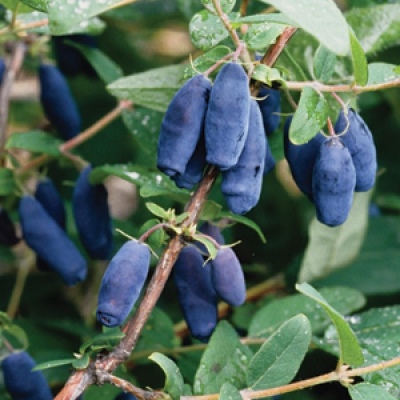
- Authors: V.S. Ilyin, N.A. Ilyina (South Ural Research Institute of Horticulture and Potato Growing)
- Growth type: medium-sized, vigorous
- Description of the bush: medium spreading
- Bush height, m: 1,6-2
- Escapes: medium thickness, straight, medium pubescent, direction of shoot growth close to vertical
- Leaves: large, deep green, elongated, lanceolate
- Transportability: high
- Crown: round, medium density
- Fruit size: average
- Fruit weight, g: 1,25-1,5
Distinguishing edible from inedible honeysuckle is easy. The inedible berries are red and orange, while the black and blue ones can be eaten. There are a lot of varieties of edible honeysuckle now. And you can choose not just an edible, but also a very tasty variety, for example, a fragrant sweet and sour variety of Bazhovskaya, and plant it on your site.
Breeding history
Work on the creation of a culture was carried out on the basis of the South Ural Research Institute of Fruit and Potato Growing Nina Alekseevna and Vladimir Sergeevich Ilyins - breeders, authors of 80 varieties of currants, gooseberries, honeysuckle, sea buckthorn and rose hips. The new variety was obtained by crossing sweet Kamchatka and productive Altai varieties. The Bazhovskaya honeysuckle variety is the pride of Chelyabinsk breeders.
Description of the variety
Bazhovskaya belongs to medium-spreading shrubs that have many well-bending shoots. The bush can reach 1.5 m in height or even grow up to 2 m. Young branches are slightly pubescent, they are green or purple. The leaves are large, dark green in color, the leaf plates are located oppositely on the stem.
Fruit characteristics
Dark blue berries are elongated, their surface is bumpy. The fruit is quite thick, a bit like a barrel. The berry weighs 1.25–1.5 g, sometimes up to 1.8 g.
Taste qualities
The pulp of Bazhovskoy is juicy, soft, has a pleasant aroma, there is no bitterness. The tasters gave the highest score for the taste characteristics: 4.8–5. The fruits in the composition have a lot of useful substances: vitamins, minerals. The sugar content is 7%.
Ripening and fruiting
Fruiting in a culture begins 3-4 years after planting, but can sometimes give the first harvest in the year of planting the seedling. Ripening periods are average. Bears fruit annually, can bear fruit for 30, and sometimes 40 years.
Yield
The culture is considered high yielding. The average productivity of one bush is 1.5–2 kg. The maximum yield is 3.0–3.5 kg per bush, or 19 c / ha.

Self-fertility and the need for pollinators
The culture is considered self-fertile; cross-pollination is necessary for the crop to ripen. For this, such varieties of honeysuckle as Sineglazka, Amphora, Blue Spindle, Sorceress are ideal.
Growing and care
The choice of a territory for planting a culture is considered one of the most important moments in the cultivation of Bazhovskaya honeysuckle, because in one place the bush will grow for at least 20-25 years. Therefore, it is better if it is a sun-drenched corner in the garden, where there are no gusts of wind. The presence of partial shade is undesirable, this reduces the yield.
It is impossible to locate Bazhovskaya where groundwater runs closer than a meter to the earth's surface. The culture has no special requirements for soil.It just shouldn't be sandy or swampy. If the soil is acidic on the site, then the land can be limed 1 month before planting.
The optimal distance between honeysuckle bushes in one row will be 1.5–2 m, and the row spacing - 2–2.5 m. Bushes must not be allowed to close, as this will lead to thickening of the plants and, accordingly, to a decrease in yield.
The right time for planting Bazhovskaya honeysuckle is spring, after the snow has melted, during the period of bud swelling. If the moment is missed, the planting is postponed to the autumn period, usually to the last 10 days of September, so that the seedlings have time to take root before the first frost.



Winter hardiness and the need for shelter
The culture is very winter-hardy, capable of bearing fruit even after winter, when the frosts were down to -47 ° C. Cases have been recorded when, after lower temperature indicators, individual specimens of the described honeysuckle retained the ability to bear fruit. In addition, Bazhovskaya is also drought tolerant.
































































